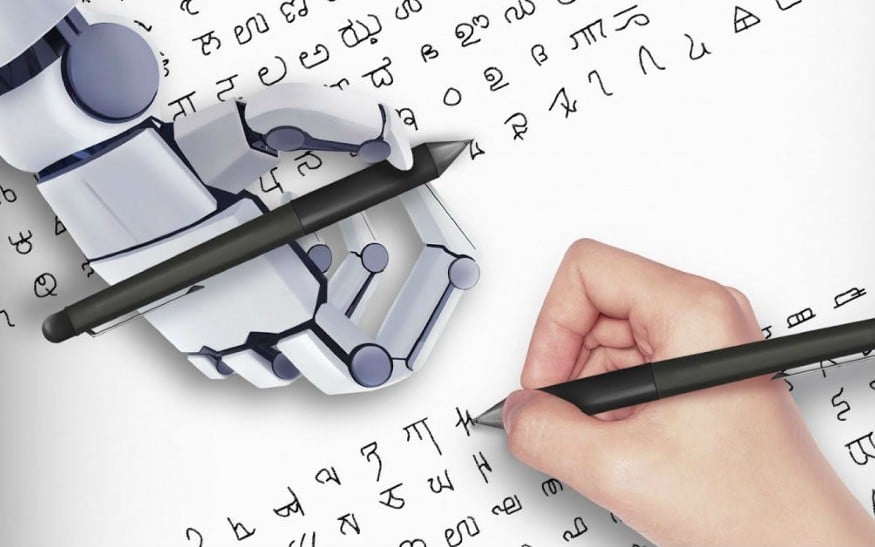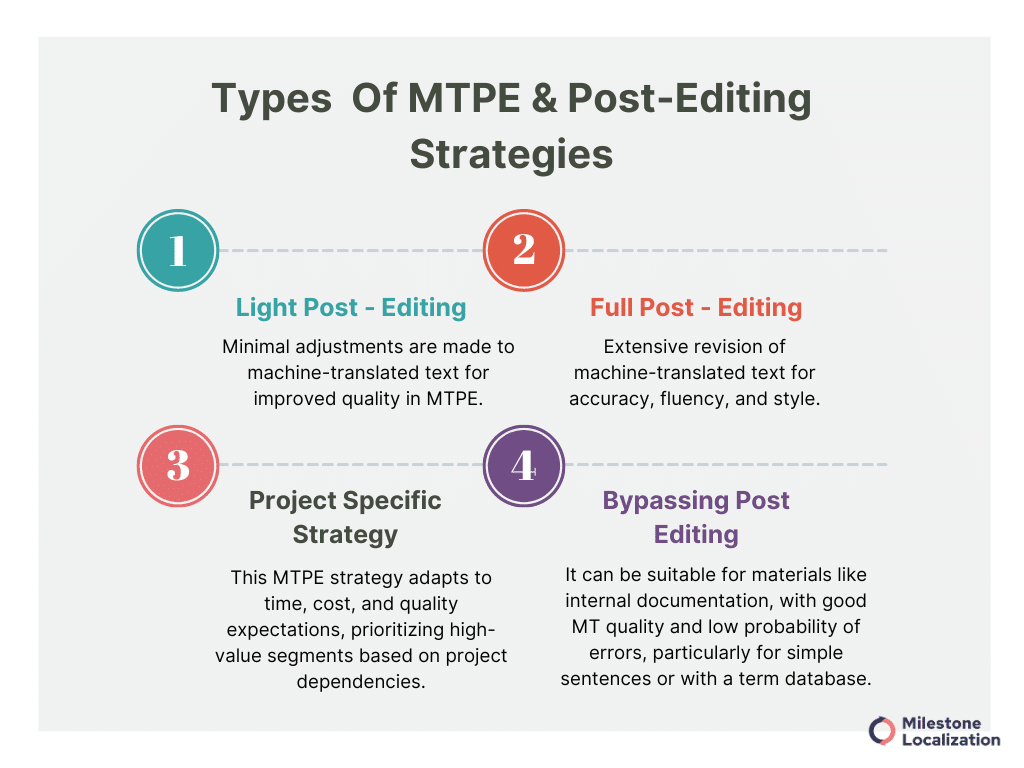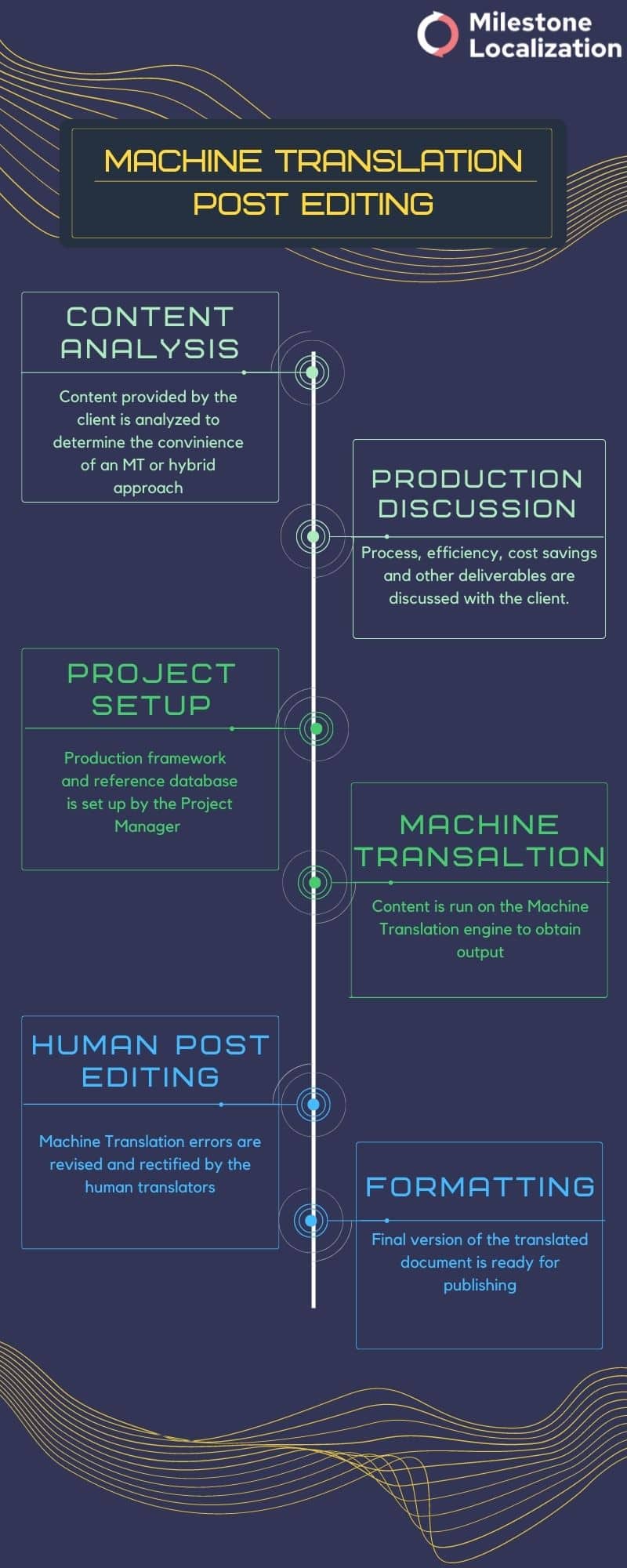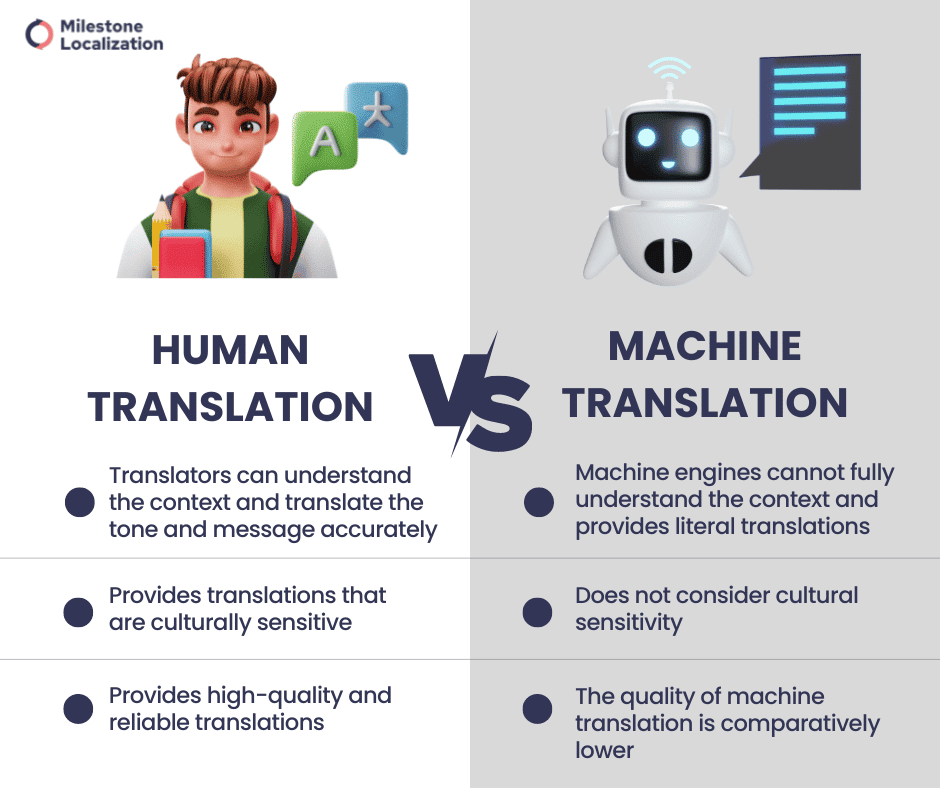Machine translation (MT) is a hot topic nowadays. Computers and algorithms continue to evolve and improve translation quality.
Humans, however, remain key figures in the translation process.
Machine Translation or MT or the automatic translation from one natural language to another natural language by computer software based on certain rules and statistics. There is no human intervention in the translation process.
Machine Translation Post Editing or MTPE is the process where a human linguist reviews and edits the translation done by a machine. Human linguists check and correct grammar, sentence structure, context and tone.
Although MT and MTPE have only recently gained popularity, this technology exists for probably longer than you expect.
Are You Looking For Machine Translation Post Editing Services?
Get the speed and efficiency of a machine with the quality guarantee of human translators. Our MTPE services are currently available in 35+ languages.
History of Machine Translation
1949 could be deemed as the set-off point for MT. In this year Warren Weaver, a researcher at the Rockefeller Foundation, presented his proposal for machine-based translations, inspired by information theory and code-breaking techniques during WWII.
Initially, MT served military interests only. Later on, however, MT began to be used to cater to civilian needs as well.
Additionally, in the age of globalization, fast and efficient translation became a necessity for any business.
As a result, at the turn of the century, many companies released online translation services. One of them was Babel Fish.
Their service worked with a limited range of languages and its rule-based system lacked extra-textual knowledge. This meant it got confused by expressions such as “see” and “sea”.
This type of MT works with general engines or in other words they are used to translate general content (hence the name) without specialized technology.
This is also the reason why they fail to recognize colloquial expressions or artistic language.
Another influential idea is the statistical MT which was initially used for Google Translate.
This type of MT is, so to say, self-learning, meaning it continually increases its corpus. What’s more, it works on the principle of two parallel texts.
Statistical or vertical MT engines can be “trained” to use specific terminology for a specific domain (e.g. travel, manufacturing, etc.).
The newest approach is neural MT, which however is not a drastic step from SMT. This approach utilizes an artificial neural network to predict the likelihood of a sequence of words.
Also read: AI Language Translation: Can AI Replace Human Translators?
These MT engines will never be as meticulous as human translation, although they are constantly evolving.
This resulted in the emergence of MTPE or in other words, computers and human translators working together to achieve fast-quality results.
In this blog, we will present you with a detailed MT and MTPE guide to making sure you are well-acquainted with the latest trends and most importantly, know how to incorporate them to fit your needs!
Machine Translation vs Machine Translation Post-editing
What is machine translation?
Machine Translation refers to the automated process of translation from source material into another language. In recent years MT engines have improved immensely due to the advent of new software and hardware.
Nowadays these engines can process millions of words per hour while still retaining the high quality of the translation.
Moreover, MT engines can be used for nearly every language. However, MT has a hard time recognizing idioms or more colloquial expressions. Have a look at Google Translate:
This first example is a wrong translation from Bulgarian to English. Google translate fails to recognize a rather popular colloquial expression in the Bulgarian language. “I feel so sleepy that I can’t see two” should be translated simply to “I’m very tired”.
This is an excerpt from the book “Sie nannten sich der Wiener Kreis (“They Called Themselves the Vienna Circle”) by Karl Sigmund. Have a look at the phrase “den Ungeraden” which is translated as “the odd ones”.
Although that translation is not completely wrong, in this context it is not a good choice. The German phrase is used to denote the “politically undesirable people”, so “the odd ones” is a little too vague.
MT cannot and probably will never be able to recognize the different tones and meanings in human language which reduces the quality of the translation drastically.
This is when MTPE comes in.
Also read: Pros & Cons Of Using Google Translate For Business
What is machine translation post-editing?
MTPE is a hybrid between machine translation and human translation. This in turn means a twofold benefit for the client – high speed and high quality.
As could be inferred from its name, the MT is followed by a post-editing process which is fulfilled by a human translator. Their job is to edit the material for better accuracy, flow, clarity, and local resonance.
It might be hard to decide which one would better suit your needs – MT or MTPE. If this is the case, have a look at the pros and cons of each:
Mistranslations Note: MT is prone to making a wide range of mistakes such as:
- Wrong word order, gender, or number
- Missing/wrong articles
- Wrong punctuation
- Words in the target text left out in the source language
Once we have cleared out what are the positive and negative sides of MT and MTPE, you might have already made up your mind about which one you want to use. If this is not the case, however, or you are still unsure, we have your back!
When you can use machine translation
- If you need to translate the content as fast as possible
- Limited budget
- If a rough translation will be sufficient (e.g. low-priority internal messages)
- If you have large volumes of text that need to be translated.
When you can use machine translation post-editing
- If you need a culturally sensitive or very precise translation
- And if you are translating a text that requires technical knowledge (e.g. medicine, mechanics, law, etc.)
- If you are working with public-facing materials (e.g. ads or product descriptions)
Also read: 11 Elements To Consider For A Successful Localization Strategy
Are You Looking For Machine Translation Post Editing Services?
Get the speed and efficiency of a machine with the quality guarantee of human translators. Our MTPE services are currently available in 35+ languages.
Types of MTPE and post-editing strategies
The post-editing process depends on your expectations which should be specified in advance. The three main points to keep in mind are time, cost, and quality since they would determine your post-editing strategy.
Light Post-editing (LPE)
- as few edits as possible
- to ensure legible and accurate output
- fast and cost-effective PE approach
Full Post-editing (FPE)
- a thorough review of the MT
- focuses on consistency of tone, correct grammar, and appropriateness of the expressions
- aims to sound natural, native
- slower and more expensive approach than LPE
- high-quality translation
Project-specific Strategy
- requirements are project-dependent
- certain segments can be prioritized if they have higher business value
- can be adapted to your expectations for time, costs, quality
Bypassing Post Editing
- could work very well with some materials (e.g. internal documentation)
- MT quality is expected to be good
- Low probability for bad translations (e.g. very simple sentences or a database of terms)
Also read: Top Qualities Of A Good Translation
Does machine translation work for all languages and dialects?
Without a doubt, MT has come a long way since its advent in the late 40s. Thanks to the progress in the development of processing technology, it is constantly getting better.
Also read: Emerging Trends in Translation Technology
However, MT tends to work much better with some language combinations than with others.
Generally, MT performs with widely spoken languages very well (e.g. English, German, French). Moreover, it is best to use MT between English and European languages since they are related.
Milestone Localization chooses the best engine for a particular language pair and subject matter based on data and experience. Different engines give different levels of accuracy depending on the language pair and content.
On the contrary, translations between languages like English and Japanese, which are disparate, generally do not work very well.
The same goes for dialects. There is no machine to translate specifically into Canadian French or Colombian Spanish.
As a rule of thumb, European languages have similar grammatical structures since they are more closely related.
In both cases, however, mistakes still occur especially when dealing with languages that have more complex grammar and syntax (e.g. Turkish and Russian).
MTPE, on the other hand, can deal with such ambiguities, of course, with the help of a human translator during the post-editing process.
Also Read: What are the fastest growing languages?
Is MTPE suitable for all types of content?
Generally, MT works best with clear and concise content. Ideally, a sentence should have simple grammar and not more than 20 words.
Headline-style sentence segments and long, complex sentences do not work well with MT.
Also, for MT to provide high-quality translations, it is best to work with literal texts since it tends to struggle to recognize tones such as sarcasm or humour.
Moreover, double negations (e.g. it won’t do you any good) or some very colloquial expressions are real obstacles for MT.
If you want to ensure the best results, consider revising your text so that is prepared specifically for MT.
When it comes to MTPE, good candidates would be instruction manuals, website content, blog posts, or packaging inserts.
When to use only human translation?
It is not advisable to use raw MT for materials aimed at your audience or such that need to reflect your brand’s message. Creative segments such as headlines or slogans should be translated by human translators without any machine intervention.
Also, when translating highly technical texts or materials containing sensitive issues, jokes, or a certain tone, it is preferable to opt for human translation.
In such cases, completely eliminating machines is advisable. This is because making sense of and correcting machine translation can be more time-consuming than doing a human translation from scratch.
Also read: 8 ways to overcome multilingual translation challenges as a translator
Machine translation post-editing rates: How much can you save?
To put it shortly, MTPE efficiency is very difficult to predict. Without a doubt, MT speeds up the translation process.
Moreover, according to a Sandford University study regardless of language pairs or the translator’s professional experience, MTPE is considerably faster than translating from scratch.
Indeed, most professional translators work more quickly as editors than as from-scratch translators.
The initial MT translation can save translators up to a few hours of work. This makes MTPE one of the quickest ways to get a high-quality translation.
As a result, human translation costs a lot more than MT since it simply takes longer.
For common languages like German, French, Spanish, and Dutch, MT quality is usually upwards of 65%.
When our clients use MTPE, they can save up to 30% on translation costs.
By using MTPE for your project, you can take the best of both worlds – MT and human translation.
Therefore, MTPE would mean major cost savings without having to compromise quality.
Also read: Localization & Translation Costs – Breakdown Of Factors Involved
Conclusion
The Roman philosopher Cicero had once said that translation should be “non verbum de verbo, sed sensum exprimere de sensu”
which means “not word for word but sense for sense”.
Well, MT has come a long way, however, it is still not able to do “sense to sense” translation. In fact, its purpose has never been to replace human translators but to make their job easier and faster.
MTPE, on the other hand, is a new approach to translation that incorporates computers and human translators to grant the client premium quality translations at lower rates!
To get MTPE right, you need the help of professionals. From choosing the right MT engine for your language pair and subject matter to training linguists to post-edit, expertise, and experience are required.
Contact us for professional MTPE services.
Also read: Top 10 Translation Companies In India
Are You Looking For Machine Translation Post Editing Services?
Get the speed and efficiency of a machine with the quality guarantee of human translators. Our MTPE services are currently available in 35+ languages.












